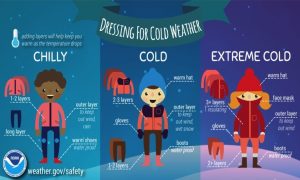
Every year, nearly 1,000 people die due to hypothermia. Working and just moving about in cold environments requires people to be aware of the risk of hypothermia and frostbite, and to understand the dangers of low windchills. Understanding how to protect the body from excessive exposure in cold conditions is crucial. The ambient temperature and duration of exposure to cold are keys in determining the level of risk from exposure. This risk can be reduced by following the guidelines below:
LAYERING
Proper layering using light-weight and comfortable fabrics that trap the air warmed by the body, while allowing moisture vapor from perspiration to be conducted away from the skin.
WICKING
The first layer for cold weather exposure should keep you warm and dry. The best materials for long underwear are those that “wick” wetness away from the skin quickly and effectively. Synthetic fibers dry quickly and pull perspiration vapor away from the skin toward the insulation layer where it can evaporate.
INSULATION
Warmth and dryness are crucial factors. Insulating layers may need to be added if the activity level tapers off. The best insulators (wool, goose down) will trap warm air but still provide ventilation. Clothing should be comfortable and light-weight, durable, and windproof.
THE SHELL
Outerwear should be appropriate for the activity. Jackets and pants must allow perspiration vapor to vent while blocking wind and rain. The material must reduce heat loss and assist the rest of the layers in providing dryness and comfort.
COVERING YOUR HEAD, HANDS, AND FEET
In addition to layering, it is very important that the head, hands, and feet are protected from the damp and cold.
- Head. The head and neck lose heat faster than any other parts of the body. Covering the head is critical; unlike the hands and feet, the blood supply does not become constricted in the cold. This is why body heat escapes through the head more readily than the hands or feet.
- Hands. In order to preserve heat to vital organs the body limits the amount of blood pumped to the extremities. That’s why hands and feet are the first things to get cold – they’re being “sacrificed”, for the more important body parts. Wear gloves that are breathable and waterproof.
- Feet. Feet can get cold quickly and allow heat to escape. The feet generally can pump a full cup of perspiration over the course of an active day. Footwear should be durable, waterproof and breathable, and should include synthetic fiber socks with a thin pair of wicking socks.
- Wear shoes or boots that provide traction and are designed to grip snow or ice.
- Hard, smooth-soled shoes are not designed for walking on such slippery surfaces.
- You can change into your office shoes once you are inside your building.
- Wear flat-soled footwear for better stability; avoid footwear with higher heels.
- If you do not have footwear with proper slip-resistant soles, then invest in a removable pair of traction devices that provide special gripping for walking on snow and ice, such as Yaktrax. [Remember to remove when entering buildings.].
- Wear shoes or boots that provide traction and are designed to grip snow or ice.
You must be logged in to post a comment.